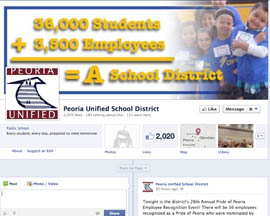Cronkite News has moved to a new home at cronkitenews.azpbs.org. Use this site to search archives from 2011 to May 2015. You can search the new site for current stories.
Arizona’s public schools getting creative to compete for students
PHOENIX – Conducting exit interviews with students and parents who choose charter or private schools over public schools.
Buying theater advertisements promoting individual public schools.
Developing robust social media operations to connect parents with public schools, whether it be encouraging contributions to a canned food drive or noting an upcoming holiday.
Facing increased competition for students and the funding that comes with each, many public schools and districts are embracing new ways of promoting themselves.
And others should follow suit by touting signature programs and showing their value in other ways, according to Nedda Shafir, communications consultant for Arizona School Administrators.
“When I went to school (in Arizona) I went to my neighborhood school, and my parents would have never considered elsewhere,” Shafir said. “It is a different landscape now.”
The Deer Valley Unified School District uses exit interviews, hosts focus groups with returning families and studies what programs and opportunities nearby charter schools offer, said Ashley Morris, a district spokeswoman.
The district also published an advertisement online and in local newspapers picturing Deer Valley teachers and programs. “Is your child provided with the same opportunities at your charter school?” it said.
Morris said traditional public schools can provide quality sports, International Baccalaureate and career programs rarely found in charter or private schools.
“We understand that there’s a reason options exist, and we can only give what we have the capabilities to give,” Morris said. “We just want people to know what we have, what we offer, how we can prepare a student.”
Erin Dunsey, the Peoria Unified School District‘s media specialist, said 30 of the district’s 40 schools now have social media sites to keep parents informed and engaged. Sites highlight high achievers, ask parents to get involved and provide community resources.
The district also hosts an annual patron tour that allows parents and community members to visit two schools and experience a typical day.
“For a prospective parent, it’s a personal look at what our schools are like,” Dunsey said. “For a parent who already has a child in another school and is looking for a change, our schools might be what they have been seeking.”
During National School Choice Week, Peoria partnered with the Deer Valley Unified School District and West-MEC, a joint technical education district serving the West Valley, to publish newspaper advertisements thanking parents for choosing public districts.
Dunsey said the Peoria district hosts community education forums and, like Deer Valley, will soon incorporate exit interviews for students leaving their local public schools.
“We want to engage with parents about issues that are most important to them,” she said.
Eileen Sigmund, Arizona Charter Schools Association president, said she has noticed more public districts trying to attract families to neighborhood schools.
She said one public school district recently sent out fliers to families comparing the public and charter schools in the area.
“The past thought was, ‘I live in this ZIP code, therefore I have no choice,’” she said. “But parents now know they have options.”
Around 145,000 Arizona students – or 14 percent – attend charter schools, an increase of 10,000 from last school year. Around 54,000 students attend private schools.
As charter and private schools grow, traditional public schools lose funding for each student who leaves.
The Deer Valley Unified School District, which has seen enrollment declines for five years, competes with more than 40 charter and private schools within its boundaries.
“The students going to those other schools could be coming to Deer Valley schools, but they’re not,” Morris said.
Tracey Benson, Arizona School Boards Association‘s communications director, said schools and districts are becoming more intentional and strategic about communicating the opportunities they can provide.
“Especially in counties where competition between districts and with other school options is most intense, marketing has become a focus of school districts by necessity,” she said.
Benson said she recently drove by an elementary school bus with a sign advertising free all-day kindergarten, serving as a “traveling billboard.”
She said the two greatest assets to public districts seem to be social media and the parents themselves.
“Word of mouth is really the most effective way to attract new families to your schools,” Benson said. “Parent outreach programs have become more important – engaging the parents you have so they can become ambassadors for your schools and districts.”
Shafir, with Arizona School Administrators, said conferences for public education leaders often include sessions discussing “how to tell a school or district’s story and what kinds of people to tell it to.”
These sessions, she said, often include success stories and suggest open houses, school tours, family polling and other ways to engage families.
“For the first time, all schools have to concentrate on marketing and communications,” Shafir said. “They’ve really needed to spend extra effort in getting their stories out.”







